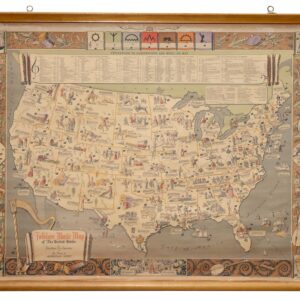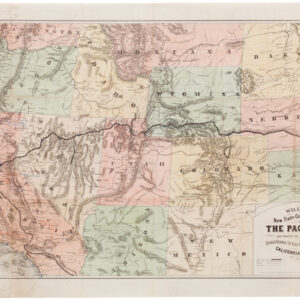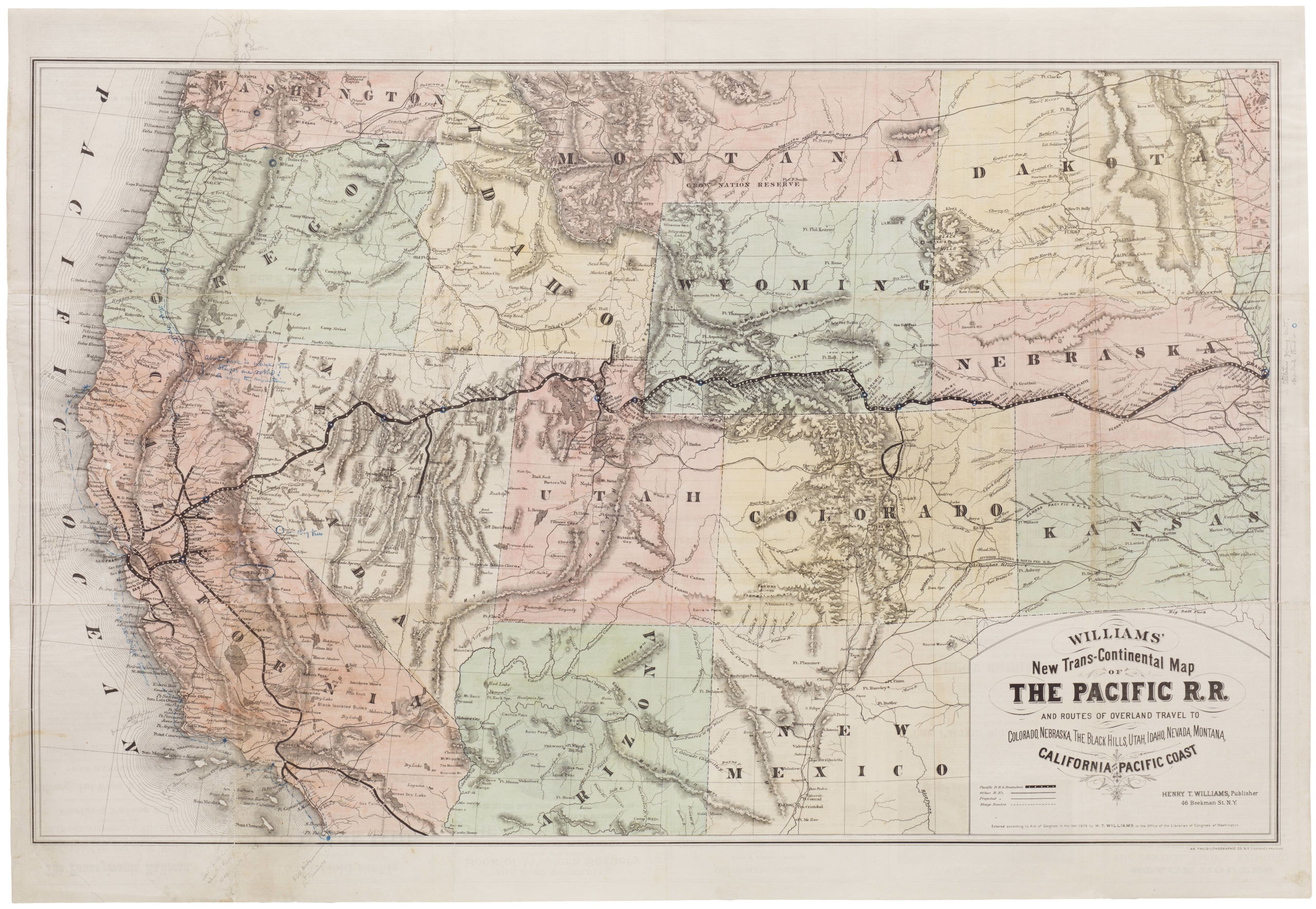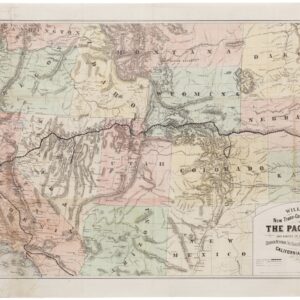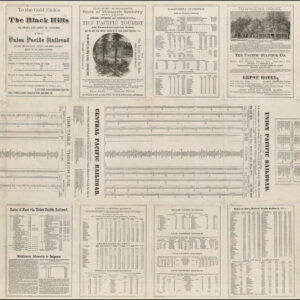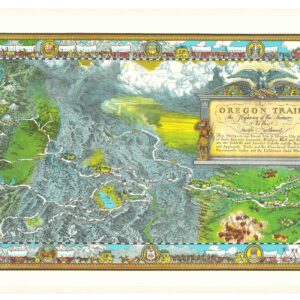The Roots of Romanticism of the American Southwest.
The Indian-detour; Santa Fe; Harveycars.
$1,400
1 in stock
Description
This scarce view and booklet was prepared by Rand McNally and Co. of Chicago for the Atchison, Topeka, and Santa Fe Railway and the Fred Harvey Company in c. 1928.
The view, looking northwest, includes Albuquerque in the foreground and Santa Fe and Taos in the background at right. Indian pueblos, cities and towns, archaeological sites (such as Bandelier National Monument), mountains, canyons, and geological features are labeled throughout. In the foreground are illustrations of American pioneer settlers, Spanish conquistadores, and indigenous peoples, including one engaged in a ritualistic dance, likely the Hopi kachina or “snake dance.” The booklet also includes text and photographs promoting the sights along the Indian Detour.
The Indian Detour
The Indian Detour was a special route offered by the Fred Harvey Company, in conjunction with the Atchison, Topeka, and Santa Fe Railway, from 1926 onwards. The routes were part of broader efforts to promote tourism and encourage travel to the Southwest, a region that was becoming increasingly popular with American and international tourists (Native peoples and cultures had already featured regularly in the advertising of both companies). The initiative was also a response to the increasing popularity of automobiles, which were cutting into the revenues of railways.
The Indian Detours were based at the Spanish Revival-style La Fonda Hotel in Santa Fe. The excursions were led by guides called “couriers,” who, like the “Harvey Girls” at other Harvey establishments, were attractive young women trained to be highly genial towards passengers. The “detours” could include travel to the ruins of Spanish missions or interesting geological sites, but almost always entailed trips to Indian “pueblos” nearby, including Zuni, Navajo, Pueblo, and Hopi settlements.
These excursions contributed significantly to the perception of the Southwest’s Native American groups in the American popular imagination. This romanticized view rested on the commodification and sometimes appropriation of Native cultures (“couriers” dressed in Navajo-style clothing) and reflected the now-subjugated status of Native peoples. At the same time, the company had established an “Indian Department” as early as 1901 that cooperated with indigenous craftspeople, which was surprisingly inclusive and respectful for the time (arguably before the last battles of the Indian Wars had been fought, including skirmishes in Arizona and New Mexico into the 1910s).
The Indian Detour was badly hurt by the drop-off in tourism with the Great Depression and further expansion of private automobiles. Attempts to revive the service in the post-World War II period failed, but the trips had already profoundly impacted the region and its broader perception.
Harveycars and the Atchison, Topeka, and Santa Fe
Fred Harvey (1835 – 1901) opened a hospitality business in 1875 after recognizing the need for accommodations and food for the growing numbers of migrants and travelers taking the long-distance, transcontinental routes across the United States. Harvey quickly developed a close, contractual relationship with the Atchison, Topeka, and Santa Fe Railroad (ATSF), and the two companies grew as their symbiotic relationship blossomed in the late 19th century. By the early 20th century, as automobiles became more widespread, Harvey’s successors (namely his son, Ford) developed a twelve-passenger autobus service to reach locations “off the beaten path” that were inaccessible by railway. This was a clever way to adjust to travelers’ changing times and tastes, adding some rugged adventure to the relatively luxurious experience of rail travel.
Census
This booklet was originally printed by Rand McNally and Co. in 1926 and then reprinted in 1927, but a pastedown notes changes that took effect in May 1928, indicating that it was distributed around or after that date. Given the uncertainty over the title and date (later reprints were also issued in 1928 and 1929), there are multiple catalog listings in the OCLC that may refer to this work. Regardless of edition or printing, it appears that examples of booklets with this title are held by about twenty-five institutions in the OCLC.
Cartographer(s):
Fred Harvey (1835–1901) was a British-born American entrepreneur who transformed the hospitality and food service industry in the United States during the late 19th and early 20th centuries. Born in London, England, he emigrated to the U.S. in the 1850s, where he initially worked as a dishwasher and clerk, gaining experience in the restaurant and service industries. In the 1870s, Harvey partnered with the Atchison, Topeka, and Santa Fe Railway (ATSF) to create a network of restaurants and hotels along the railway lines. Recognizing the need for reliable, high-quality dining options for long-distance travelers, he opened the first Harvey House restaurant in Topeka, Kansas, in 1876.
Rand, McNally & Co.In 1856, William H. Rand opened a printing shop in Chicago and two years later hired a newly arrived Irish immigrant, Andrew McNally, to work in his shop. In 1868, the two men, along with Rand’s nephew George Amos Poole, established Rand McNally & Co. and bought the Tribune’s printing business. The company initially focused on printing tickets and timetables for Chicago’s booming railroad industry, and the following year supplemented that business by publishing complete railroad guides.
The first Rand McNally map, created using a new cost-saving wax engraving method, appeared in the December 1872 edition of its Railroad Guide. Rand McNally became an incorporated business in 1873; with Rand as its president, McNally as vice president, and George Poole as treasurer.
Rand McNally published its first road map, the New Automobile Road Map of New York City & Vicinity, in 1904.
Condition Description
Excellent.
References
